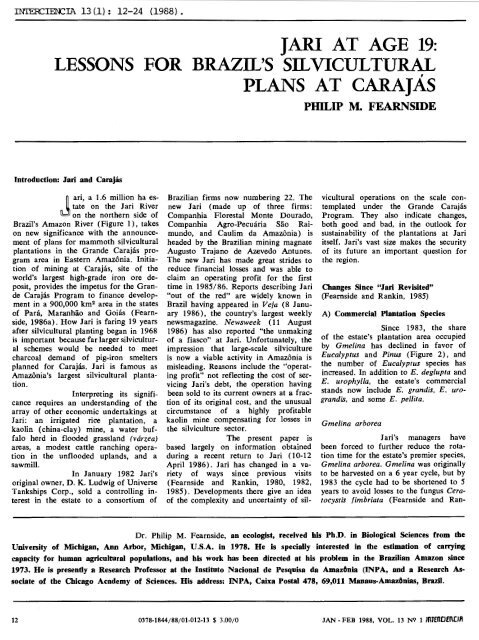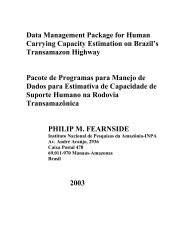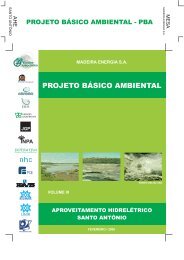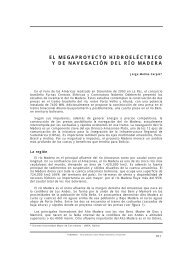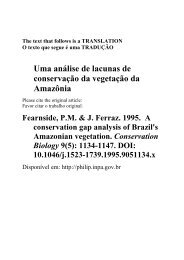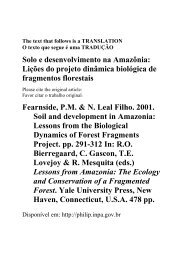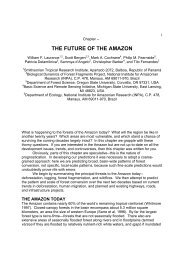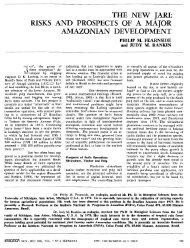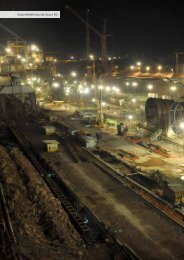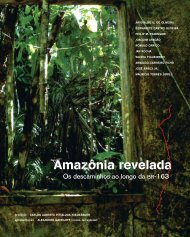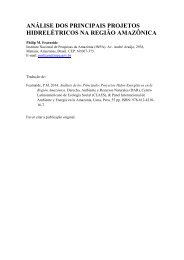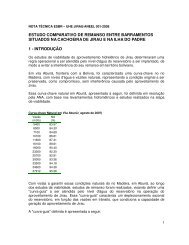jari at age 19 - Philip M. Fearnside - Inpa
jari at age 19 - Philip M. Fearnside - Inpa
jari at age 19 - Philip M. Fearnside - Inpa
Create successful ePaper yourself
Turn your PDF publications into a flip-book with our unique Google optimized e-Paper software.
INI'ERCIEN::IA 13 (.1) : 12-24 (.<strong>19</strong>88) •JARI AT AGE <strong>19</strong>:LESSONS FOR BRAZIL'S SIL VICULTURALPLANS AT CARAJASPHILIP M. FEARNSIDEIntroduction: Jari and CarajasJari, a 1.6 million ha est<strong>at</strong>eon the Jari Riveron the northern side ofBrazil's Amazon River (Figure 1), takeson new significance with the announcementof plans for mammoth silviculturalplant<strong>at</strong>ions in the Grande Carajiis programarea in Eastern Amazl\nia. Initi<strong>at</strong>ionof mining <strong>at</strong> Carajiis, site of theworld's largest high-grade iron ore deposit,provides the impetus for the GrandeCarajas Program to finance developmentin a 900,000 km 2 area in the st<strong>at</strong>esof Para, Maranhao and Goiiis (<strong>Fearnside</strong>,<strong>19</strong>86a). How J ari is faring <strong>19</strong> yearsafter silvicultural planting began in <strong>19</strong>68is important because far larger silviculturalschemes would be needed to meetcharcoal demand of pig-iron smeltersplanned for Carajiis. J ari is famous asAma:zOnia's largest silvicultural plant<strong>at</strong>ion.Interpreting its significancerequires an understanding of thearray of other economic undertakings <strong>at</strong>Jari: an irrig<strong>at</strong>ed rice plant<strong>at</strong>ion, akaolin (china-clay) mine, a w<strong>at</strong>er buffaloherd in flooded grassland (varzea)areas, a modest c<strong>at</strong>tle ranching oper<strong>at</strong>ionin the unflooded uplands, and asawmill.In January <strong>19</strong>82 Jari'soriginal owner, D. K. Ludwig of UniverseTankships Corp., sold a controlling interestin the est<strong>at</strong>e to a consortium ofBrazilian firms now numbering 22. Thenew Jari (made up of three firms:Companhia Florestal Monte Dourado,Companhia Agro-Pecmiria Sao Raimundo,and Caulim da Ama:zOnia) isheaded by the Brazilian mining magn<strong>at</strong>eAugusto Trajano de Azevedo Antunes.The new J ari has made gre<strong>at</strong> strides toreduce financial losses and was able toclaim an oper<strong>at</strong>ing profit for the firsttime in <strong>19</strong>85/86. Reports describing Jari"out of the red" are widely known inBrazil having appeared in Veja (8 January<strong>19</strong>86), the country's largest weeklynewsmagazine. Newsweek ( 11 August<strong>19</strong>86) has also reported "the unmakingof a fiasco" <strong>at</strong> Jari. Unfortun<strong>at</strong>ely, theimpression th<strong>at</strong> large-scale silvicultureis now a viable activity in Ama:zOnia ismisleading. Reasons include the "oper<strong>at</strong>ingprofit" not reflecting the cost of servicingJari's debt, the oper<strong>at</strong>ion havingbeen sold to its current owners <strong>at</strong> a fractionof its original cost, and the unusualcircumstance of a highly profitablekaolin mine compens<strong>at</strong>ing for losses inthe silviculture sector.The present paper isbased largely on inform<strong>at</strong>ion obtainedduring a recent return to Jari ( 10-12April <strong>19</strong>86). Jari has changed in a varietyof ways since previous visits(<strong>Fearnside</strong> and Rankin, <strong>19</strong>80, <strong>19</strong>82,<strong>19</strong>85). Developments there give an ideaof the complexity and uncertainty of silviculturaloper<strong>at</strong>ions on the scale contempl<strong>at</strong>edunder the Grande CarajiisProgram. They also indic<strong>at</strong>e changes,both good and bad, in the outlook forsustainability of the plant<strong>at</strong>ions <strong>at</strong> Jariitself. Jari's vast size makes the securityof its future an important question forthe region.Changes Since "Jari Revisited"(<strong>Fearnside</strong> and Rankin, <strong>19</strong>85)A) Commercial Plant<strong>at</strong>ion SpeciesSince <strong>19</strong>83, the shareof the est<strong>at</strong>e's plant<strong>at</strong>ion area occupiedby Gmelina has declined in favor ofEucalyptus and Pinus (Figure 2), andthe number of Eucalyptus species hasincreased. In addition to E. deglupta andE. urophylla, the est<strong>at</strong>e's commercialstands now include E. grandis, E. urograndis,and some E. pellita.Gmelina arboreaJari's man<strong>age</strong>rs havebeen forced to further reduce the rot<strong>at</strong>iontime for the est<strong>at</strong>e's premier species,Gmelina arborea. Gmelina was originallyto be harvested on a 6 year cycle, but by<strong>19</strong>83 the cycle had to be shortened to 5years to avoid losses to the fungus Cer<strong>at</strong>ocystisfimbri<strong>at</strong>a (<strong>Fearnside</strong> and Ran-Dr. <strong>Philip</strong> M. <strong>Fearnside</strong>, an ecologist, received his Ph.D. in Biological Sciences from theUniversity of Michigan, Ann Arbor, Michigan, U.S.A. in <strong>19</strong>78. He is specially interested in the estim<strong>at</strong>ion of carryingcapacity for human agricultural popul<strong>at</strong>ions, and his work bas been directed <strong>at</strong> his problem in the Brazilian Amazon since<strong>19</strong>73. He is presently a Research Professor <strong>at</strong> the Instituto Nacional de Pesquisa da Amaz6nia (INPA, and a Research Associ<strong>at</strong>eof the Chicago Academy of Sciences. His address: INPA, Caixa Postal 478, 69,011 Manaus-Amaz6nias, Brazil.12 0378-1844/88/01-012-13 $ 3.00/0 JAN- FEB <strong>19</strong>88, VOL. 13 N9 1 IRlfR[IfR[IA
kin, <strong>19</strong>85: 121). Jari now harvests itsGmelina <strong>at</strong> the young <strong>age</strong> of 3-4 yearsto avoid the fungus, which has becomemore severe. In the case of Gmelinagrown from stump sprouts, or coppices,early cutting is also wise due to weakgrowth after the fourth year. Shortenedrot<strong>at</strong>ions imply substantial increases inproduction costs: planting, weeding andharvesting oper<strong>at</strong>ions have to be doneregardless of rot<strong>at</strong>ion length.The Cer<strong>at</strong>ocystis fungus<strong>at</strong>tacks coppiced Gmelina more severelythan Gmelina planted as seeds or seedlings.Since coppiced Gmelina growsfaster than trees planted from seed (inthe first 4 years), J ari's man<strong>age</strong>rs hopeth<strong>at</strong> sufficiently resistant stock can bedeveloped to allow use of the coppices.Coppiced Gmelina would also be advant<strong>age</strong>ouson the more steeply-sloping sitesto minimize erosion between crops.Breeding continues in ayet unsuccessful effort to develop linesof Gmelina resistant to Cer<strong>at</strong>ocystis. Jari'spast successes in improving Gmelinagrowth form are being transferred to theplant<strong>at</strong>ions in the Gmelina th<strong>at</strong> is notallowed to grow back as coppices. Thelimited size of the present seed orchardhas cre<strong>at</strong>ed a short<strong>age</strong> of improved seedstock. A 70 ha area in a commercialstand is now being thinned for conversionto an additional source of seed.Gmelina is being innocul<strong>at</strong>edwith Cerawcyszis fungus insome parts of the commercial plant<strong>at</strong>ionsin an effort to select resistantstock. Experiments are also underwayin which infected trees are cut and leftin the plant<strong>at</strong>ions (r<strong>at</strong>her than being removed)in order to see if this cheapermeasure would be sufficient to controlthe fungus.A new fungus has appeared<strong>at</strong> J ari, <strong>at</strong>tacking 100 ha ofGmelina in October and November <strong>19</strong>85.The as yet unidentified fungus causedleaves to fall off the trees, but the treessurvived and the leaves have since grownback.Applying fertilizers tocommercial Gmelina plant<strong>at</strong>ions, begunin <strong>19</strong>82 (<strong>Fearnside</strong> and Rankin, <strong>19</strong>85:123), has been discontinued. The cost ofbalancing nutrient removals will eventuallyhave to be paid if production is tobe sustained.Bulldozing to removestumps, known as "intensive site prepar<strong>at</strong>ions,"is being done <strong>at</strong> a r<strong>at</strong>e of 3000-4000 ha/ year, which is as fast as Jari'scurrent capabilities allow. At this r<strong>at</strong>e itwould take 25-33 years to destump the approxim<strong>at</strong>ely1 00,000 ha area deforestedso far. Jari's man<strong>age</strong>rs do not plan todestump the steeply-sloping areas, wherethe erosion hazard is gre<strong>at</strong>est. However,the staff fear th<strong>at</strong> increasing costof manual labor will eventually makeunmechanized use of the steeply-slopingareas uneconomic.J ari's silviculture staffacknowledge th<strong>at</strong> they will not be ableto plant more than a very few cycles ofGmelina on the steeply-sloping sites dueto erosion. If man<strong>age</strong>ment of the resprouts(coppices) proves impracticaldue to the Cer<strong>at</strong>ocystis fungus, then thesesites will either have to be abandonedor converted to a perennial crop (oilpalm, etc.) or to a long-cycle rot<strong>at</strong>ionof hardwood species. Tests with perennialcrops (cacao) and planted hardwoods(teak) were discontinued underthe previous administr<strong>at</strong>ion when theyproved uneconomic (<strong>Fearnside</strong> and Rankin,<strong>19</strong>80).Jari already has abandonedGmelina stands totaling 793 ha(226 ha planted from seed and 567 haresprouted as coppices) . Abandonmentis the likely f<strong>at</strong>e of an area of approxim<strong>at</strong>ely1500 ha in the Pacanarf sectorloc<strong>at</strong>ed on "p<strong>at</strong>io" soil, a very poorplinthosol (apparently Block 69-76).The staff believe th<strong>at</strong> some of the abandonedGmelina stands th<strong>at</strong> were cut andthen left unman<strong>age</strong>d may yet produce <strong>at</strong>least a little useful wood, since the millcan accept very thin logs.Pinus caribaeaCarribean pine (Pinuscaribaea) is viewed with increasingenthusiasm by Jari's man<strong>age</strong>rs for anexpanded role in the future. Growth ofPinus caribaea, now being planted onslightly better soils than before, has beengood, in some cases with yields as highas those of Eucalyptus. Jari's man<strong>age</strong>rsreport th<strong>at</strong> good growth has been achieved on some (unvisited) sites withpoor soil quality. One of these sites ison a sandy soil in its second rot<strong>at</strong>ion.Pinus caribaea normallyhas slow growth in the first 3 years,after which the r<strong>at</strong>e increases. Pinus hasproduced up to 14.5 m tons/ha/year inyoung plant<strong>at</strong>ions on the best pl<strong>at</strong>eausoils, but only around 8 m tons/ha/yearin the areas to be harvested. Low yieldsare blamed on lack of adequ<strong>at</strong>e weedingduring the transition phase. The best<strong>19</strong>73 area (Block 43-73/86) produced23 m tons/ha/year when harvested <strong>at</strong>the <strong>age</strong> of 13 yea~.Attack of the fungusCylindrocladius deslupario in Pinus firstbecame a worry in <strong>19</strong>84 when Eucalyptusurograndis (a susceptible species)was introduced on a commercial scale <strong>at</strong>Jari. The fungus is increasing steadily inthe E. urograndis stands but is remaining<strong>at</strong> a stable level in Pinus. When thi~fungus <strong>at</strong>tacks a tree the needles dry upbut the tree is not killed.Fires have caused noserious dam<strong>age</strong> since <strong>19</strong>83, despite drywe<strong>at</strong>her. Fire is an inherent hazard inplant<strong>at</strong>ions of Pinus and has caused significantdam<strong>age</strong> <strong>at</strong> Jari in the past(<strong>Fearnside</strong> and Rankin, <strong>19</strong>80, <strong>19</strong>85). Asa precaution, J ari is now leaving widerfirebreaks of n<strong>at</strong>ive forest between plant<strong>at</strong>ionblocks.The staff say th<strong>at</strong> theproblem of fires spreading into theplant<strong>at</strong>ions from slash-and-burn fieldsin squ<strong>at</strong>ter claims has diminished. Thecompany has established a "Rural SettlementNucleus" (NAR) to resettle squ<strong>at</strong>tersand has assigned three social assistantsto the resettlement sites. Theplant<strong>at</strong>ion staff st<strong>at</strong>e th<strong>at</strong> the squ<strong>at</strong>tershave been accepting reloc<strong>at</strong>ion and th<strong>at</strong>burning in the community fields in theresettlement area is done after informingJ ari staff so th<strong>at</strong> precautions can betaken. I did not visit any of the resettlementsites. It is unclear how many ofthe 1500-2500 squ<strong>at</strong>ter families presentin <strong>19</strong>83 have accepted resettlement."Foxtailing" (the tendencyto long branchless apical shoots) isstill a problem in Jari's Pinus caribaea.Genetic m<strong>at</strong>erial was selected in ca. <strong>19</strong>78from 50 of the best trees, but the progenyof these trees (being raised in Moro doSol in the st<strong>at</strong>e of Minas Gerais) havenot yet had sufficient time to produceseed for commercial plant<strong>at</strong>ions.The need to keep thepulp mill supplied with chips has obligedJ ari to harvest Pinus <strong>at</strong> the <strong>age</strong> of 9years. The quality of pine pulp is highest<strong>at</strong> an <strong>age</strong> of 11 years, as the fiber lengthincreases <strong>at</strong> a r<strong>at</strong>e of about 5% per yearin the 9-11 year <strong>age</strong> interval. Long fibersgive resistance to tearing. The decisionto harvest Jari's pine <strong>at</strong> 9 years r<strong>at</strong>herthan waiting longer therefore carries theopportunity cost of foregoing two or moreyears of growth with minimal expensesfor weeding and other maintenance workand results in some sacrifice of productquality.J ari's planning departmentclassified 728 ha of Pinus standsas "abandoned" as of February <strong>19</strong>86. Inaddition, an area of approxim<strong>at</strong>ely 3000ha where Pinus has grown poorly is being11\JfR(Ifi\WI JAN -FEB <strong>19</strong>88, VOL. 13 N'? 113
TABLE IPLANTATION AREAS AT 1ARI lalGmelina GmelinaYear of from from Pinusplanting seed coppices caribaeaEuca-Eucalyptus Eucalyptus Eucalyptus lyptusdeglupta urophylla urograndis pellita<strong>age</strong> of 3-4 years so th<strong>at</strong> the flow of chipsto the mill can be maintained. 1ari man<strong>age</strong>rsalso point to the advant<strong>age</strong> ofreplacing E. deglupta stands with improvedvarieties of better Eucalyptusspecies. 1ari's October-December dry periodhas a gre<strong>at</strong>er impact on the droughtsensitiveE. deglupta than on other Eucalyptusspecies. E. deglupta also has theadvant<strong>age</strong> of being resistant to the Cylindrocladiusdeslupario fungus, but otherfactors make phasing out E. deglupta alogical decision since the disease doesnot presently inflict severe dam<strong>age</strong>.Eucalyptus deglupta <strong>at</strong>1ari is plagued by the presence of polyphenolsin the wood. These non-saponifiableresiduals cause the core of thelower part of the trunk to become dark,readily apparent in the piled wood awaitingchipping. Some trunks, even thoughlight in color when cut into cross sectionsfor sampling, turn dark after a fewhours indic<strong>at</strong>ing the presence of polyphenols.Were they not removed polyphenolswould stain the pulp, loweringits market price. The US$6/ m ton extracost of removing polyphenols from E.deglupta will maintain the firm's reput<strong>at</strong>ionfor top quality pulp until E. urophyl-EucalyptusCammercarnal-N<strong>at</strong>ive Experi- cia!dulensis species mentul total1S70 0 0 0<strong>19</strong>71 0 0 0<strong>19</strong>72 0 0 0<strong>19</strong>73 0 0 148<strong>19</strong>74 0 0 270<strong>19</strong>75 0 0 10<strong>19</strong>76 34 0 238<strong>19</strong>77 0 0 727<strong>19</strong>78 0 0 4,595<strong>19</strong>79 0 0 4,824<strong>19</strong>80 12 0 732<strong>19</strong>81 0 786 593<strong>19</strong>82 0 365 1,234<strong>19</strong>83 1,002 5,996 3,448<strong>19</strong>84 1,005 2,100 6,792<strong>19</strong>85 2,536 3,391 4,512<strong>19</strong>86 0 I b) 0 0 lc)Total 4,589 12,638 28,123(a) Areas in hectares as of February 24, <strong>19</strong>86.(b) 4500 ha scheduled for planting in <strong>19</strong>86.(c) 7300 ha scheduled for planting in <strong>19</strong>86.(d) 460 ha scheduled for planting in <strong>19</strong>86.(e) 18~0 ha scheduled for planting in <strong>19</strong>860 0 0 00 0 0 00 0 0 00 0 0 00 0 0 00 0 0 00 0 0 00 0 0 00 0 0 00 0 0 0263 0 0 01,940 0 0 07,461 ' 166 0 04,807 2,757 0 640 7,392 142 00 3,127 849 00 0 (d) 0 (e) 014,471 13,442 991 640 0 14 00 0 3 00 0 56 00 0 <strong>19</strong> 1480 0 0 2700 0 23 100 0 12 2720 0 <strong>19</strong> 7270 0 49 4,5950 0 <strong>19</strong> 4,8240 0 63 1,0070 0 55 3,4852 0 27 11,8<strong>19</strong>0 27 14 22,8780 130 101 14,0030 0 92 10,4390 0 0 02 157 566 74.477converted to pasture following harvestof the pine in <strong>19</strong>86 (Block 85-78). Silviculturalstaff do not know why this firstcyclestand grew slowly but suggest aspossible causes soil factors and competitionfrom pasture grass initially interplantedwith the pine. Pinus caribaeaareas interplanted with c<strong>at</strong>tle pasturewhen the pine trees were in their thirdthrough fifth year of growth have anadditional weed problem from the remainsof' the pasture when the areas areused for a second cycle of pine. 1 ari'sman<strong>age</strong>rs st<strong>at</strong>e th<strong>at</strong> the conversion topasture will be made because of the existinginfrastructure (corrals and fences)<strong>at</strong> th<strong>at</strong> site, not due to poor growth ofthe pine trees. The Pinus in the areascheduled for conversion to pasture grew<strong>at</strong> only about half the r<strong>at</strong>e of trees onbetter sites. 1 ari's man<strong>age</strong>rs st<strong>at</strong>e clearlyth<strong>at</strong> planting pasture in former plant<strong>at</strong>ionareas is not contempl<strong>at</strong>ed as a sinkfor exhausted soils.Eucalyptus deglupta1 ari has not plantedEucalyptus deglupta since <strong>19</strong>83 and isnow harvesting this species <strong>at</strong> the earlyIa, which has no phenols, comes on linein <strong>19</strong>88.1 ari maintains a stockof E. deglupta germplasm selected forlow polyphenol content. This leaves openthe option of returning to E. degluptashould fungal or other problems becomesevere in altern<strong>at</strong>ive species.Pulp quality is lowerfrom Eucalyptus grown on poor soils.This, combined with advant<strong>age</strong> of increasedgrowth r<strong>at</strong>e, may explain why allEucalyptus species are fertilized <strong>at</strong> 1 ari.No other species is fertilized in commercialplant<strong>at</strong>ions <strong>at</strong> the est<strong>at</strong>e.Eucalyptus enters intoconflict with Gmelina for the optimaltime of year for harvesting. Gmelina isbest harvested in the dry season becausethe steeply sloping clay soils often plantedto this species have a higher potential forerosion and because machinery is difficultto use in these hilly areas duringthe rainy period. E. deglupta is also bestharvested in the dry season due to thelower content of "extractibles" (impurities)th<strong>at</strong> have to be removed from thepulp if harvested <strong>at</strong> this time. Gmelinaalso has more impurities in the rainyseason, although the beige-colored im-14JAN- FEB <strong>19</strong>88, VOL. 13 N'-' 1 IR1fR[IfRWI
TABLE IIROTATIONS AND YIELDS OF SILVICULTURAL SPECIES AT JARIWeightharvested BarkRot<strong>at</strong>ion with bark (% drySpecies (years) (m tons/ha) weight)Gmelina arborea 4 45-50 20Eucalyptus deglupta 4 60-70 10Eucalyptus urophy/la 4 66-80.5 20Pinus caribaea 9 120-130 24-25TABLE IllWOOD GROWTH BALANCE AT JARIWood yieldArea (m tonslhalSpecies (ha) year) (a)Gmelina arborea 17,227 9.5Pinus caribaea 28,123 5.25Eucalyptus deglupta 14,471 14.625E. urophylla, E. urograndis& E. pel/ita 14.499 14.65Other commercial &experimental plant<strong>at</strong>ions 725 14.65 (c)TOTAL 75,200 9.92(a)I b)(c)Midpoints of ranges in Table II.Guess (50% of E. deglupta value).Assumed equal to E. urophy/la value.CALCULATION OF SHORTFALLMill requirement = 3000-3500 m tons/day of chips(midpoint = 3250 m tonslday)Annual requirement (allowing for 2 week shutdown for repairs)351 days x 3250 = 1,140,750 m tons of chips (dry weight)Annual shortfall = 1,140,750 - 951,435 = 189,315 m tons of chipsN<strong>at</strong>ive woodsupplement(% of mix)504020 (b)20 (b)Shortfall from plant<strong>at</strong>ion sources = 189,315 x (1 - 0.156) = 159,782 m tonsAdditional plant<strong>at</strong>ion area needed (<strong>at</strong> present configur<strong>at</strong>ion and yields)159,782 1 9.92 m tonslhalyr aver<strong>age</strong> yield = 16,107 haExpansion needed as percent<strong>age</strong> of present plant<strong>at</strong>ion area =16,107 ha 1 75,200 ha = 21.4% increasepurities in Gmelina cause less problemsthan do the black ones in E. deglupta.The density of E. deglupta<strong>at</strong> Jari is lower than th<strong>at</strong> of Eucalyptusin Brazil's Central-South Region.To avoid the lower quality pulp th<strong>at</strong>would result from using its E. degluptain pure form, J ari has developed a mixof n<strong>at</strong>ive species th<strong>at</strong> includes 40% "capitarf(Tabebuia insignis, BIGNONIACEAE).Wood yield(m tons/hajyear)9.0-10.013.5-15.7513.2-16.15.0-5.5Total wood(plant<strong>at</strong>ion &n<strong>at</strong>ive)(m tons/year)172,270147,646352,730265,51313,276951,435The supplement of wood from n<strong>at</strong>iveforests also significantly reduces the costof supplying the mill's requirements forchips.Jari had 1847 ha ofabandoned E. deglupta as of February<strong>19</strong>86. These stands had apparently beenplanted on inappropri<strong>at</strong>e sites; no planshave been made for conversion of theareas to other uses.Eucalyptus urophyllaThe Cylindrocladius fungus<strong>at</strong>tacks E. urophylla, but trees arenot killed and growth reduction is apparentlynot gre<strong>at</strong>. E. urophylla suffersless <strong>at</strong>tack than does E. urograndis. Currentlythere is more Cylindrocladius onthe Amapii side of the Jari River thanon the Para side; some of the staff ascribethe difference to heavier clay soil on theAmapii side.A bacterial disease causedby Pseudomonus solonacearum has appearedin E. urophylla, mostly in youngtrees. The bacteria <strong>at</strong>tack the roots ofthe trees; the leaves turn yellow and thetree dies. The technical staff firstobserved symptoms in <strong>19</strong>84. Since th<strong>at</strong>time the disease has spread but has notreached alarming levels.A lepodopteran larva<strong>at</strong>tacked E. urophylla in <strong>19</strong>85, but dam<strong>age</strong>was reportedly not serious. A microhymenopteran<strong>at</strong>tacked part of one block(Block 35) in <strong>19</strong>85, but has not increasedsince. Neither of the insects hasyet been identified.E. UrograndisE. urograndis is a hybridof E. urophylla males and E. grandisfemales produced by interbreeding inopen plant<strong>at</strong>ions. Since the crossfertiliz<strong>at</strong>ionis not done under strictly controlledconditions, the "E. urograndis" standscontain a sc<strong>at</strong>tering of individuals of theparent species in addition to the hybrids.E. urograndis is themost susceptible to the Cylindrocladiusdeslupario fungus of the major commercialEucalyptus species <strong>at</strong> Jari. Theeffects are worse in the young trees. The<strong>at</strong>tack is worse in the rainy season. Thefungus slows the growth r<strong>at</strong>e of the treeswithout killing them.Eucalyptus cancre (thefungus Diaportha cubensis) is the Achilles'sheel of E. grandis. Cancre <strong>at</strong>tack isnot evident in the hybrid <strong>at</strong> Jari.E. pellitaJari has E. pellita on asmall scale: 64 ha were planted in <strong>19</strong>83(in parcels spread throughout the est<strong>at</strong>e) ,but Jari's man<strong>age</strong>rs are now postponingfull commercial-scale planting until theysee the effects of the Cylindrocladiusfungus. In one 12 ha plot of E. pellita16% of the trees were <strong>at</strong>tacked in thefirst year, and some trees died. Nevertheless,in <strong>19</strong>86 the experimental parcelsin the est<strong>at</strong>e were augmented by an additional200 ha.ll\7fR[/ffi[lfl JAN- FEB <strong>19</strong>88, VOL. 13 N9 115
B) Experimental Plant<strong>at</strong>ion SpeciesJari's ability to we<strong>at</strong>herfuture biological problems will be largelydetermined by the availability of altern<strong>at</strong>ivesilvicultural species. Adequ<strong>at</strong>etesting of potential species, carried out<strong>at</strong> the site, is the best means of minimizingthe risk of an inappropri<strong>at</strong>e choice.The following species are under testing:E. grandis: Jari installeda 14 ha experimental planting of E.,grandis from a loc<strong>at</strong>ion in Australiabelieved to be similar to J ari. Trees fromthis procedence are thought to offer agood chance of resisting the cancre th<strong>at</strong>often <strong>at</strong>tacks plant<strong>at</strong>ions of this species.Finding altern<strong>at</strong>ive Eucalyptus species isa sufficiently high priority <strong>at</strong> J ari th<strong>at</strong>14 ha of one-year-old commercial pineplant<strong>at</strong>ion were sacrificed to install theexperiment in <strong>19</strong>85.E. camaldulensis: Althoughthis species is sometimes used forpulp (United St<strong>at</strong>es, NAS <strong>19</strong>80: 126) theonly potential use for it <strong>at</strong> Jari would befor firewood. Despite enthusiasm amongthe research staff under Ludwig and goodgrowth in experimental plant<strong>at</strong>ions(<strong>Fearnside</strong> and Rankin, <strong>19</strong>82), thespecies is no longer under consider<strong>at</strong>ionfor commercial plant<strong>at</strong>ion due to poorpulping characteristics.E. tornelliana: This speciesgrows well <strong>at</strong> Jari, quickly shadingout the undergrowth. However, it is nota good pulping species and only can beused for firewood.E. brassiana: Growthsince testing began in <strong>19</strong>84 has not beengood.E. pillularis: A test plotof this species planted in <strong>19</strong>85 is tooyoung to be evalu<strong>at</strong>ed.Pinus oocarpa: Thisspecies has poorer growth than P. caribaeain the first two years but thenc<strong>at</strong>ches up and grows faster. P. oocarpamust be maintained with more thoroughweeding than P. caribaea until it reachesa height of two meters (in approxim<strong>at</strong>elytwo years). P. caribaea can surviveeven if left in a heavily weed-infestedstand with only the tips of the treesshowing. P. oocarpa often starts itsgrowth lying down or in other ways th<strong>at</strong>produce poor form. It also has morebranches and side sprouts near theground. The staff consider P. oocarpa tobe more susceptible to the Cylindrocladiusfungus than is P. caribaea. It alsohas high variability in the growth amongindividual trees - not a good characteristicfor plant<strong>at</strong>ions, but one th<strong>at</strong> allowsrapid genetic selection. P. oocarpa basSourceTABLE IVSUPPLEMENTARY WOOD SOURCES AT JARI (<strong>19</strong>85/86)Deforest<strong>at</strong>ion for plant<strong>at</strong>ionsEMBRAPA experimentsCapitari (Tabebuia insignis)Purchase of Pinus caribaea chipsTOTAL (103 m tons)PERCENT OF TOTAL PULPWOODNote(a)(b)(c)(d)(e)Aproxim<strong>at</strong>eweight (103m tons/year)26.250.548478188.79(a) Approxim<strong>at</strong>ely 3000 ha felled for plant<strong>at</strong>ions in <strong>19</strong>85. Aver<strong>age</strong> wet weight biomass oflogs = 350m tons;ha (Feamside and Rankin, <strong>19</strong>85: 125), or approxim<strong>at</strong>ely 175 m tons/hadry weight. The dry weight pulped per hectare felled is approxim<strong>at</strong>ely 8.75 m tons, since5% of the species arc used for pulp; these species are assumed to represent the samepercent<strong>age</strong> of harvested biomass. This is consistent with the 10% of biomass used forpulping in <strong>19</strong>83 (<strong>Fearnside</strong> and Rankin, <strong>19</strong>85: 125) when twice the present number of specieswere used for pulpin~:.(b) total amount harvested = 18 x 103 m3; aver<strong>age</strong> density = 0.6; assume 5% used as innote (a).(c) 4 month Eucalyptus run ( = 120 days) x 700 ~ tons capitari/day.(d) 390 x 103 m tons chip demand (From Table V) x 20% supplied from purchases (<strong>19</strong>85;86value).(e) 1,140,750 m tons for oper<strong>at</strong>ion <strong>at</strong> full capacity (see Table III).the advant<strong>age</strong> of very little foxtailing ascompared to P. caribaea. The species isconsidered a potential option for commercialplanting should a change be desirable,but J ari has no immedi<strong>at</strong>e plansfor such a change.Anthocephalus chinensis:This species, which had been growingwell in an experimental stand on fairlygood soils (<strong>Fearnside</strong> and Rankin, <strong>19</strong>80),died mysteriously in <strong>19</strong>84 <strong>at</strong> an <strong>age</strong> ofapproxim<strong>at</strong>ely six years. No diseasesymptoms, insect <strong>at</strong>tack, or other problemswere evident.Casuarina: Testing ofthis Asian legume was enthusiasticallyiniti<strong>at</strong>ed under the previous man<strong>age</strong>mentin about <strong>19</strong>79. The species is only usabfefor firewood. Experiments are not continuing."Para-Para" (Jacarandacopaia): This n<strong>at</strong>ive species has goodgrowth but requires rel<strong>at</strong>ively fertilesoil. Many but not all trees are <strong>at</strong>tackedby Hysipyla shootborers (pit mothlarvae) (<strong>Fearnside</strong> and Rankin, <strong>19</strong>80).Small-scale experiments continue."Mungubeira" ( Bombaxmunguba): Experiments th<strong>at</strong> were initi<strong>at</strong>edshortly before the end of Ludwig'stenure have not been pursued. Mungubeirais a n<strong>at</strong>ive of the Amaz:Onianvtirzea and grows well there.17%"Taxi Preto" (Triplarisfilipensis): A 1 ha plot of this n<strong>at</strong>ivespecies was planted in <strong>19</strong>85. The youngtrees suffered some dam<strong>age</strong> by grasshoppersand ants.To summarize the st<strong>at</strong>usof the search for new species, both exoticand n<strong>at</strong>ive, Jari has a number of speciesunder testing, a few of which have givenreasonably positive results <strong>at</strong> the site. Nospecies is currently <strong>at</strong>tractive enough tosuggest any likely changes in the choicesfor commercial plant<strong>at</strong>ions over the nextfew years, but some are sufficiently welladapted th<strong>at</strong> they could be called uponshould biological problems arise th<strong>at</strong> arehighly damaging to Pinus caribaea or thecurrent Eucalyptus species. No such safeguardexists in the case of J ari's hallmarkspecies: Gmelina arborea. No n<strong>at</strong>ivespecies are under serious consider<strong>at</strong>ionfor commercial planting.C) Silvicultural Man<strong>age</strong>mentOne casualty of the costcuttingmeasures during Jari's financialsqueeze has been the recycling of some ofthe pulp mill's residuals to the plant<strong>at</strong>ions.In the long term the outflow ofnutrients through biomass harvesting,soil erosion and other p<strong>at</strong>hways must be16JAN- FEB <strong>19</strong>88, VOL. 13 NQ 1 ll\7fR(Ifl\(ltl
alanced by inputs. The practice initi<strong>at</strong>edin <strong>19</strong>83 of returning some of the nutrientsremoved, although small in scale,was an important sign of recognition ofthis limit<strong>at</strong>ion.Leaf cutter ant (Atta)control is now more effective than itwas under the previous man<strong>age</strong>ment.Mirex baits are still the most importantcomponent: J ari now uses 50-60 m tonsper year of Mirex (as compared to 100-120 m tons/year before <strong>19</strong>83): TheMirex is applied to a larger area thanpreviously, but the area has a lower infest<strong>at</strong>ionof the ants. Mirex is appliedto all plant<strong>at</strong>ions, whether they are to beharvested th<strong>at</strong> year or not. Baits are alsoplaced in a 100 m sw<strong>at</strong>h in the forestaround all of the plant<strong>at</strong>ions. Mirex isput out in the dry season, and is mosteffective just after burning when thereis nothing else for the ants to carry awayto feed the fungal gardens in their nests.Leaf cutter ant controlin the rainy season relied on the liquidinsecticide Arbinex. From <strong>19</strong>83 to <strong>19</strong>86J ari used 10 thousand liters per year ofthe poison; new Brazilian environmentalregul<strong>at</strong>ions now prohibit its use. Methylbromide gas, which was pumped into theleaf cutter ant nests as a part of theAtta control program during Ludwig'stenure, has since been discontinued asoverly expensive.Burning, a necessarypart of the site prepar<strong>at</strong>ion process forplant<strong>at</strong>ion establishment, failed over a totalof 3000 ha <strong>19</strong>85. Due to the onsetof the rains, burns failed in a 1500 haarea th<strong>at</strong> had been felled in Felipe(Amapa). N<strong>at</strong>ive forest wood was removedfrom 1200 ha before the rainsprecluded further work; secondary forestgrowing up on the site will be cut andburned for plant<strong>at</strong>ion establishment in<strong>19</strong>87. Two areas in Para did not burneither. Heavy rains preventing burningin some years severely affects c<strong>at</strong>tleranchers and small farmers throughoutAmaz.Onia (<strong>Fearnside</strong>, <strong>19</strong>86b, and) Jari'sfailure to burn a substantial portion ofits clearing in <strong>19</strong>85 will save money inthe short term since the expense of plantingthese areas was deferred but willprolong the period of insufficient plant<strong>at</strong>ionarea to meet the mill's wood demands.Improved knowledge ofthe est<strong>at</strong>e's soil and we<strong>at</strong>her, and of therequirements of the species planted, iscontinuing to reduce the risk of majorman<strong>age</strong>ment blunders. The importanceof the high variability of Amaz.Oniansoils has been amply demonstr<strong>at</strong>ed <strong>at</strong>J ari, from the initial c<strong>at</strong>astrophic mistakeTABLE VCALCULATION OF CONTRIBUTION FROM NATIVE WOOD AT JARIPulpSupplement asproduction percent of Supplementaryin <strong>19</strong>84/85 (a) Chips required plant<strong>at</strong>ion con- woodSpecies (103 m tons) (103 m tons) (b) tribution (c) (103 m tons)Gmelina arborea 82 355.3 5.263 18.7Pinus caribaea 90 390.0 0 0Eucalyptus deg[upta 42 182.0 25 45.5TOTAL 214 927.3 64.2(a)(b)(c)(d)From Table VIICalcul<strong>at</strong>ed from r<strong>at</strong>io of chip demand to pulp production3250 m tons chips : 750 m tons pulp ( = 4.33 : 1)Derived from percent<strong>age</strong> of mix given in Table III:x p/(1 - p) where:x = supplement as proportion of plant<strong>at</strong>ion contributionp = supplement as proportion of mix (total wood)Contribution from capitari (Tabebuia insignis) only; some upland forest trees are also used.of planting large areas of Gmelina onsandy soils (<strong>Fearnside</strong> and Rankin,<strong>19</strong>80) to the subsequent adjustments reflectedin the areas abandoned or convertedto other uses. A top priority ofJ ari's current research effort is a detailedsoil survey of the est<strong>at</strong>e. Once this inform<strong>at</strong>ionis in hand, it is hoped th<strong>at</strong>the growth records of plant<strong>at</strong>ions on thesites will yield a series of regressions formore accur<strong>at</strong>e prediction of plant<strong>at</strong>ionyields on different sites. This is clearlyessential for reliable long-range planning.J ari's increased numberof planted pulp species represents an importantsafeguard against biological problemsin any given species, as well as ameans of making better use of the varietyof soil qualities present in the est<strong>at</strong>e.Planting a still broader range of specieswould be highly advisable.Breeding of improvedsilvicultural varieties continues. The potentialgains from investment in geneticimprovement are very gre<strong>at</strong>: because thecost of production is so high rel<strong>at</strong>ive tothe price received for the est<strong>at</strong>e's pulp,even small increments in the yield perhectare represent large percent<strong>age</strong> gainsin profits (or cuts in losses).Silvicultural tre<strong>at</strong>mentsare being readied in prepar<strong>at</strong>ion for possiblelong-range changes in Brazil's laboreconomy. Motorized mowers are nowweeding some stands of Pinus and Eucalyptus(but not Gmelina). The staff areconcerned th<strong>at</strong> the presently very loww<strong>age</strong>s in Brazil for manual labor couldrise sharply, significantly increasing thecompany's costs. Such changes in manuallabor costs have forced abandonmentof silvicultural plant<strong>at</strong>ions in some othercountries (see <strong>Fearnside</strong> and Rankin,<strong>19</strong>80). The company r<strong>at</strong>her have a smallernumber of better-qualified and betterpaidmachine oper<strong>at</strong>ors settled with theirfamilies than a large number of migrantlaborers for manual weed control. Migrantlaborers come with diseases such asmalaria, filling up the hospitals andcre<strong>at</strong>ing social problems. Nor will theirchildren ever provide a settled pool ofqualified labor. Antunes backs the effortto cre<strong>at</strong>e a pool of skilled labor rooted<strong>at</strong> Jari and has agreed to pay for a secondaryschool in Monte Dourado to giveagronomic and silvicultural training tolocal youth.Rooting staff <strong>at</strong> J ari isimportant <strong>at</strong> all levels in the companyhierarchy. Turnover in the technical staffhas been extremely high. Of the 22 personsin a <strong>19</strong>82 photograph of the technicalstaff <strong>at</strong> the pulp mill, only two werestill <strong>at</strong> Jari by <strong>19</strong>86. Technical staffturnover has been due largely to lowsalaries, now-one third to one-half thelevel of Jari's <strong>19</strong>80 salaries in real terms.Other firms have been able to tempt J ariemployees away, sometimes taking entiredepartments <strong>at</strong> once. Although salariesin many Brazilian government institutionshave fallen even further than J ari'ssalaries during the same period, thepriv<strong>at</strong>e sector competes successfully byoffering slightly higher pay. In addition,J ari would have to offer higher salariesto hold employees who would r<strong>at</strong>her livenear a large urban center.ll\1fR(Ifl\(lll JAN -FEB <strong>19</strong>88, VOL. 13 N9 117
Although the plant<strong>at</strong>ionswere begun in <strong>19</strong>68, it is misleading toassume th<strong>at</strong> the firm bas the benefit of<strong>19</strong> years of silvicultural experience <strong>at</strong> thesite. The high turnover in personnel basresulted in virtually no living memory ofthe earlier years among those in positionsof technical responsibility. I was frequentlysurprised to find myself called uponas a source of inform<strong>at</strong>ion about wh<strong>at</strong>had been done under the previous man<strong>age</strong>ment.High turnover can beparticularly detrimental to long-term researchprojects, since silviculture experimentsby n<strong>at</strong>ure take years to produceresults. Adequ<strong>at</strong>e record-keeping is essentialto insure against the loss of inform<strong>at</strong>ionfrom past experience in theface of staff turnover. The formal experimentsset up by the research departmentare usually well recorded, but asubstantial body of research inform<strong>at</strong>ionis gener<strong>at</strong>ed informally from spur-of-themomentiniti<strong>at</strong>ives in the forest man<strong>age</strong>mentdepartment. These research initi<strong>at</strong>ivesare a healthy way of quickly obtainingrough inform<strong>at</strong>ion on the responseto vari<strong>at</strong>ions in fertilizer applic<strong>at</strong>ion,weeding, and other man<strong>age</strong>ment techniques.When informal trials of this typegive promising results, the research departmentfollows them up by formal controlledexperiments. Examples includefertilizer use in compacted soil in formerlog stor<strong>age</strong> decks and the use of moreeconomically handled tubes for plantingseedlings in the nursery. Much of the inform<strong>at</strong>iongained from informal trials islost when the staff leave Jari.The new J ari has hadthe benefit of a stable man<strong>age</strong>ment <strong>at</strong> thetop, in sharp contrast to the est<strong>at</strong>e's pasthistory. While Ludwig hired and firedover 30 directors over the course of his14-year tenure, a single director led theenterprise from the time control passedto the present consortium in <strong>19</strong>82 untilhe stepped down in July <strong>19</strong>86. Theformer director will continue to particip<strong>at</strong>ein J ari's man<strong>age</strong>ment in an advisorycapacity.D) Use of N<strong>at</strong>ive ForestFewer species of treesfrom the n<strong>at</strong>ive forest are used for pulp<strong>at</strong> J ari than previously. Only 5% of then<strong>at</strong>ive species are for pulping: the listbas been reduced from 80 species usedin <strong>19</strong>83 to 40 species in <strong>19</strong>86. Only thosespecies with long fibers, which resisttearing, are now used. The heavier n<strong>at</strong>ivewoods break the lighter Eucalyptus.Fig. 1 .Loc<strong>at</strong>ion and fe<strong>at</strong>ures of Jari.A significant addition tothe Eucalyptus deglupta pulp has beenwood from "capitari" (Tabebuia insignis),a tree obtained from n<strong>at</strong>ural forest inthe floodplain along the lgarape !pitinga,a tributary to the J ari River near itsconfluence with the Amazon. Harvest isfrom December through July, duringwhich time the mill consumes daily 700m tons wet weight of the species. An8000 ha tract of capitari is being cutover the <strong>19</strong>85-<strong>19</strong>87 period, 5000 ba ofwhich bad been cut by April <strong>19</strong>86. Anetwork of canals has been constructedto flo<strong>at</strong> the logs to a central collectionpoint where they are grouped into rafts,P A R Aof 25,000 logs for the 3-day trip to thepulp mill. The cut areas are not replanted,nor are they converted to w<strong>at</strong>er buffaloor rice. Capitarf makes up 40% ofthe mixture in Jari's Eucalyptus degluptapulp. Capitarf has thicker fibers andthinner walls than does Eucalyptus, resultingin better quality pulp than wouldbe obtained from pure Eucalyptus. Theest<strong>at</strong>e's "Jarilyptus" pulp is therefore notconsidered to be Eucalyptus in intern<strong>at</strong>ionalmarkets, but is classified as a differentproduct with different uses.Some n<strong>at</strong>ive "mungubeira"(Bombax munguba), another varze<strong>at</strong>ree, is also used. Its long fiber is used18JAN- FEB <strong>19</strong>88, VOL. 13 Nl' 1 ln7fR[IfnWI
to improve the mix so th<strong>at</strong> stronger celluloseis produced.An additional supplementto wood supply comes from uplandforest man<strong>age</strong>ment experiments beingconducted <strong>at</strong> Jari by the Brazilian Enterprisefor Agriculture and C<strong>at</strong>tleRanching Research (EMBRAPA). A selectivefelling experiment has established 48plots of 0.25 ha each <strong>at</strong> J ari (12 ha total).However, much larger areas areman<strong>age</strong>d for other purposes under theJari/EMBRAPA agreement: 400 ha weredesign<strong>at</strong>ed in <strong>19</strong>81 for firewood man<strong>age</strong>ment;a 400-ha pulp-man<strong>age</strong>ment areawas established in <strong>19</strong>81, and a 400-hamixed-man<strong>age</strong>ment area was establishedin <strong>19</strong>82. In <strong>19</strong>85 the first measurementswere made in the man<strong>age</strong>ment areas andin a 300-ha control plot in uncut n<strong>at</strong>iveforest. An additional 933 ha of forestis directed to cellulose productionthrough selective felling, with measurementparcels established within the tract.The EMBRAPA selectivefelling experiments provide a significantsupplement of wood for the pulp milland power plant without the expenses ofeither planting silvicultural species incleared areas or replacing the harvestedtrees in the forest areas. In Novemberand December <strong>19</strong>85, for example, 500 hawere selectively harvested among thethree tre<strong>at</strong>ments, yielding 18,000 m 3 ofwood. The harvesting scheme results in amaximum amount of wood being cut:of the 500 ha, 404 ha ( 81 % ) were cut<strong>at</strong> the highest level of intensity (removalof 35% of the aver<strong>age</strong> 166 m 3 /ha total,or an aver<strong>age</strong> of 61 m 3 I ha). The experimentitself was limited to 3 blocks of48 ha each (144 ha total), with harvestingintensities of 15, 25 and 35%. All ofthe remainder of the 500-ha tract washarvested <strong>at</strong> the highest (35%) intensitylevel. EMBRAP A has also experimentedwith clearfelling: an area was cut in thedry season of <strong>19</strong>85, logs were removedand branches left on the site, which wasnot burned. A secondary forest regrowingon the site is to be monitored toassess the utility of the species.Since over 90% of Jari'supland forests are still intact, theseforests are a major potential resource forthe company. A tree species survey isunderway beginning with areas th<strong>at</strong> aretopographically appropri<strong>at</strong>~ for futureplant<strong>at</strong>ions. Jari maps indic<strong>at</strong>e roads tothree pl<strong>at</strong>eaus where no plant<strong>at</strong>ions havebeen installed. Forest inventories arebeing done on all such pl<strong>at</strong>eaus. ByApril <strong>19</strong>86 Jari's research departmenthad surveyed 4416 ha of forest in strips50JARI 1 SPLANTATIONS0 40 70+-080060 J:+- ...,'+- 30 50 0~0~ 4020 0Cll30 ....0
TABLE VIPROJECTED WOOD AVAILABILITY AT JARIEucalyptusYear Gmelina camaldureadyItem to (from seed & Pinus Eucalyptus Eucalyptus Eucalyptus lensis & N<strong>at</strong>ive Experi-harvest coppices) caribaea deglupta urophylla urograndis pellita species mental TotalArea <strong>19</strong>86 1,<strong>19</strong>7 1,393 9,664 166 0(ha) <strong>19</strong>87 6,998 4,595 4,807 2,757 0<strong>19</strong>88 3,105 4,824 0 7,392 142<strong>19</strong>89 5,927 732 0 3,127 849Wood from <strong>19</strong>86 55,1<strong>19</strong> 74,534 601,409 9,728 0plant<strong>at</strong>ions <strong>19</strong>87 265,924 96,495 281,210 161,560 0(m tons) <strong>19</strong>88 117,990 227,934 0 433,171 8,321<strong>19</strong>89 225,226 34,587 0 183,242 49,751Wood from <strong>19</strong>86 2,901 0 400,940 2,431 0n<strong>at</strong>ive <strong>19</strong>87 13,996 0 187,479 40,390 0forest <strong>19</strong>88 6,210 0 0 108,292 2,080(m tons) <strong>19</strong>89 11,854 0 0 45,810 12,438Total <strong>19</strong>86 58,020 74,534 1,002,349 12,159 0pulpwood <strong>19</strong>87 279,920 96,495 468,689 201,950 0(m tons) <strong>19</strong>88 124,200 227,934 0 541,464 10,401<strong>19</strong>89 237,080 34,587 0 229,053 69,1892 0 146 12,56864 27 49 <strong>19</strong>,2970 130 <strong>19</strong> 15,6120 0 63 10,698117 0 27,115 767,9273,750 1,582 6,461 937,6010 7,618 2,505 797,5400 0 8,306 501,11329 0 6,754 413,075938 396 1,615 244,8160 1,904 626 1<strong>19</strong>,1140 0 2,076 72,179146 0 33,768 1,180,9974,688 1,978 8,076 1,182,4170 9,522 3,131 916,6530 0 10,383 572,292shortfallproductionor quantity as percentsurplus (m tons) of need (a)Wood <strong>19</strong>86 surplus: 40,247 104%availabiliy <strong>19</strong>87 surplus: 41,667 104%<strong>19</strong>88 shortfall: 224,097 80%<strong>19</strong>89 shortfall: 567,458 50%(a) Mill need = 1,140,750 metric tons dry weight of pulpwood chips per year,bring w<strong>at</strong>er to the paddies from theAmazon River. Previous experiments hadshown the advant<strong>age</strong>s of using this nutrient-richw<strong>at</strong>er source instead of thepresent w<strong>at</strong>er from the Ariaolos River.Rice production cost perton is US$205 (direct costs only), plusUS$133 per ton in indirect costs (administr<strong>at</strong>ion,etc.), giving a total productioncost of US$338/m ton. The pricereceived in Belem is US$350/ m ton, butthe additional expenses of freight toBelem, taxes and comissions reduce thenet amount received by J ari to US$305/m ton. The loss of US$33/m tonimplies a financial drain of US$990,000for the 30,000 m tons of rice producedin <strong>19</strong>85.All of the rice is soldwithin Brazil, <strong>at</strong> prices frozen under thecountry's "Plano Cruzado" economicpack<strong>age</strong>. Since intern<strong>at</strong>ional rice pricesare higher than domestic prices, thecompany has lost money due to the requirementto sell the rice productiondomestically. Pulp prices, by contrast,are rel<strong>at</strong>ively low on the intern<strong>at</strong>ionalmarketplace, giving J ari an advant<strong>age</strong> onthe portion of the pulp production soldwithin Brazil.The research activities<strong>at</strong> the rice plant<strong>at</strong>ion are now carried outunder a cooper<strong>at</strong>ive agreement withEMBRAPA. This is an essential element inassuring the ability of the oper<strong>at</strong>ion tocounter new biological problems in thefuture. Research <strong>at</strong> the rice project hadbeen discontinued completely in the finaltwo years of Ludwig's tenure.Kaolin mmmg: Jari'skaolin (china-clay) mine has increasedits output by expanding the number ofsettling ponds for separ<strong>at</strong>ing the kaolinfrom the slurry th<strong>at</strong> is piped from theminesite <strong>at</strong> Felipe (Amapa) to the processingplant <strong>at</strong> Munguba (Para). Themining company (CAD AM) has increasedthe pace of digging into Jari's open-pitmine and modified the procedures used <strong>at</strong>the processing plant in order to recovera higher percent<strong>age</strong> of the m<strong>at</strong>erial.Sawmill: J ari's sawmillcontinues to saw lumber from the valuabletree species encountered as land iscleared for plant<strong>at</strong>ions. The sawmill remainsa rel<strong>at</strong>ively minor part of the enterprise.W<strong>at</strong>er Buffalo: The herdof 6800 w<strong>at</strong>er buffalo <strong>at</strong> Jari in <strong>19</strong>83increased to 9300 by <strong>19</strong>86, spread over50,000 of the 70,000 ha of n<strong>at</strong>ural floodedgrasslands <strong>at</strong> Jari. Jari plans totriple the buffalo herd to 30,000 head,which would occupy all of Jari's floodedgrassland area with the exception of thepart planned for expansion of the riceproject. W<strong>at</strong>er buffalo will occupy theentire length of the Amazon Riverfront<strong>age</strong> of J ari, from the mouth of theParu River to the mouth of the Ca<strong>jari</strong>River, in addition to the est<strong>at</strong>e's islandsin the Amazon River (see Figure 1).The w<strong>at</strong>er buffalo raisingscheme includes a milk and cheeseproduction program established in l<strong>at</strong>e<strong>19</strong>84, which is currently producing 1000liters of milk per day (including butterand cheese). The cheese-making facilitieshave been moved to the Camanduiisland in the Amazon river. The newsystem has a decentralized network of20JAN- FEB <strong>19</strong>88, VOL. 13 Nil 1 IR7fR[IfRWI
corrals <strong>at</strong>op earth-fill hills. During thehigh-w<strong>at</strong>er period, these artificial hillsbecome small islands, each with an areaof 1200 m 2 • The earth-fill hills replacethe traditional "marombas" - raisedwooden pl<strong>at</strong>forms where the c<strong>at</strong>tle arepenned during the flood season. The remainingmarombas <strong>at</strong> J ari will eventuallybe replaced by the earth-fill islands.The cowboy in charge of each island isprovided with a house built over thecorral. The houses have better sanit<strong>at</strong>ionand other facilities than most traditionalfloodplain residents enjoy. The cowboy'swife is responsible for making butterfrom some of the milk. J ari had six ofthe raised corrals as of April <strong>19</strong>86 andplanned to have two more by the endof <strong>19</strong>86.The earth-fill islandsinclude a fish culture scheme still in anexperimental phase. A hole is left in thecenter of each island, cre<strong>at</strong>ing a pond.Excrement from the w<strong>at</strong>er buffalo in thecorral fertilizes the pond, where aqu<strong>at</strong>icplants (known locally as "murure") serveas food for two species of for<strong>age</strong> fish(known locally as "tamu<strong>at</strong>a" and "jijuna").These fish are e<strong>at</strong>en by the commercialspecies (pirarucu" (Arapaima gigas).Research on the fish culture schemehas been underway since <strong>19</strong>83 in a cooper<strong>at</strong>ivearrangement with EMBRAPA.There is also a smallexperimental herd of 50 w<strong>at</strong>er buffaloin the terra firme (uplands) area nearSao Miguel. This oper<strong>at</strong>es under a cooper<strong>at</strong>iveagreement with the Faculty ofAgrarian Sciences of Para (FCAP).Upland caule: Jari currentlyhas 2000 head of bovine c<strong>at</strong>tle interra /irme, mostly near Sao Miguel. Thearea of pasture will expand by 3000 h<strong>at</strong>o take advant<strong>age</strong> of install<strong>at</strong>ions, allowingthe total herd to be augmentedto 7000 head. J ari has a demand for 500-600 head/ month for me<strong>at</strong> supply. A herdof 35,000 bead would be needed tosupply this, including females kept formilk and cheese.The upland c<strong>at</strong>tle herdis no longer being man<strong>age</strong>d for on-sitereproduction. Heifers are bought andf<strong>at</strong>tened. The remaining cows of goodquality continue to be bred, and theiroffspring will be bred, but the firm'swaning interest in the breeding phasemeans th<strong>at</strong> this will fade out over a fewyears. Breeding would require more landand effort.Establishment of newinterplanted stands of pasture with Pinuscaribaea was discontinued in ca. <strong>19</strong>82for a variety of reasons (<strong>Fearnside</strong> andRankin, <strong>19</strong>85). The c<strong>at</strong>tle have sinceTABLE VIIFINANCIAL BALANCE IN JARI'S SILVICULTURE SECTOR (<strong>19</strong>84/85)Receipts:PriceQuantity (US$/ ValuePulp species Market (103 m tons) m tons FOB) (103 US$)Gmelina arborea Export 66 267 17,622Domestic 16 331 5,296Pinus caribaea Export 48 249 11,952Domestic 42 256 10,752Eucalyptus deglupta Export 31 267 8,277Domestic 11 331 3,641214 57,540Production costs(exclusive of debt service) 104,790been removed from all of the previouslyestablished interplanted stands due tothe pine's advancing <strong>age</strong>.J ari's upland c<strong>at</strong>tle pasturesare of the species Brachiaria humidicola,which was promoted throughoutthe Brazilian Amazon by EMBRAPAin the l<strong>at</strong>e <strong>19</strong>70's. An increasing <strong>at</strong>tack ofthe homopteran bug Deois incompleta(known locally as "cigarrinha") hassince led EMBRAPA to recommend An-.dropogon guianensis instead. The bugsare a serious pest on the Beh!m-BrasiliaHighway in Para and on the CuiaMSantarem Highway in northern M<strong>at</strong>oGrosso, but have not yet become a problem<strong>at</strong> Jari. Jari's ranching departmentsays th<strong>at</strong> its Brachigria humidicola pastureshave to be manually cleaned ofwoody second growth every year and replantedevery 4 years.Jari's Wood Short<strong>age</strong>J ari's mill uses 3000-3500 m tons/ day of chips for pulpingwhen oper<strong>at</strong>ing <strong>at</strong> its 750 m tons/ daynominal capacity. Chips required forfirewood have so far been supplied entirelyfrom n<strong>at</strong>ive forest. The balance betweenwood demands and the growth ofthe plant<strong>at</strong>ions is essential in evalu<strong>at</strong>ingthe project's future.A rough calcul<strong>at</strong>ion ofthe growth of the plant<strong>at</strong>ions can begained from the midpoint areas of thepresent complex of each species and <strong>age</strong>class (Table I). Using the midpoint ofLOSS IN SILVICULTURE SECfOR 47,250the yield range for each species (TableII) one can calcul<strong>at</strong>e the approxim<strong>at</strong>eamount of wood growth in the est<strong>at</strong>e'splant<strong>at</strong>ions (Table III). In order to bringplant<strong>at</strong>ion growth and wood demandsinto balance the plant<strong>at</strong>ion area wouldhave to be expanded by 21.4%, assumingthe same present percent<strong>age</strong> of eachsilvicultural species and the present supplementof n<strong>at</strong>ive wood.The wood balance overthe next few years will be critical becauseLudwig planted little in the lastyears of his tenure. The first treesplanted under the new administr<strong>at</strong>ionwill come on line in <strong>19</strong>87. In <strong>19</strong>85 thecompany was racing to obtain enoughwood to keep the mill from stopping.Measures included gleaning previouslyfelled areas for logs th<strong>at</strong> could be usedfor firewood in the power plant and theearly harvest of stands. The mill wooddemand was lower than usual: forreasons unrel<strong>at</strong>ed to the short<strong>age</strong> the pulpmill oper<strong>at</strong>ed <strong>at</strong> below capacity for severalmonths, and then stopped oper<strong>at</strong>ingaltogether for one month duringwhich repairs were effected. 1 1 >The availability of pulpwoodover the <strong>19</strong>86-<strong>19</strong>89 period can beroughly projected (Table VI) based onthe plant<strong>at</strong>ion areas and <strong>age</strong> classes(Table I) and the rot<strong>at</strong>ions and yieldmidpoints for the major species (TableII). Several optimistic assumptions aremade in the projection as estim<strong>at</strong>es ofthe contributions of the species and <strong>age</strong>classes not included in Table II. 1 2 > Theprojection indic<strong>at</strong>es th<strong>at</strong> Jari will have11\JEROERWI JAN- FEB <strong>19</strong>88, VOL. 13 N9 121
enough wood to supply its pulp mill in<strong>19</strong>86 and <strong>19</strong>87, but th<strong>at</strong> in <strong>19</strong>88 and<strong>19</strong>89 there will be a severe shortfall. In<strong>19</strong>89 the est<strong>at</strong>e would only produce halfof its pulpwood needs. The short<strong>age</strong> in<strong>19</strong>89 is approxim<strong>at</strong>ely twice as severeas it would have been if bad we<strong>at</strong>herhad not prevented the est<strong>at</strong>e from burning3000 ha in <strong>19</strong>85.Jari's Financial Situ<strong>at</strong>ionJ ari has achieved a significantimprovement by elimin<strong>at</strong>ing itsoper<strong>at</strong>ing losses. Company oficials sayth<strong>at</strong> in <strong>19</strong>82/83 J ari had an oper<strong>at</strong>ingloss of US$87 million. Oper<strong>at</strong>ing lossesfell to US$23 million in <strong>19</strong>83/84, andin <strong>19</strong>84/85 the firm had neither anoper<strong>at</strong>ing loss nor profit. A small oper<strong>at</strong>ingprofit is expected for <strong>19</strong>85-86. Oper<strong>at</strong>ingprofits and losses do not includethe cost of debt service - the paymentsof interest and principal on money owedto creditors. These costs must be substantial:Jari's debt <strong>at</strong> the time of Ludwig's( <strong>19</strong>82) sale was estim<strong>at</strong>ed to beUS$300 million (lsro E, 21 May <strong>19</strong>86),to which must be added a US$25 millionloan obtained by the new owners in<strong>19</strong>84 (Pinto, <strong>19</strong>86: 210).Jari's oper<strong>at</strong>ing costsare high in part due to its vast infrastructure,including 3500 km of roads,not counting secondary roads in theplant<strong>at</strong>ions. For comparison, the TransamazonHighway route within Ama:z.Oni<strong>at</strong>otals only about 3000 km. Expansion ofthe plant<strong>at</strong>ion area to bring growth andwood demand into balance will requirefurther increasing this infrastructure.Low pulp prices havebeen a major financial strain on Jari.The world pulp short<strong>age</strong> th<strong>at</strong> Ludwigoriginally foresaw raising pulp prices toUS$700/ton in the <strong>19</strong>80's has never m<strong>at</strong>erialized.Instead the pulp market declinedto a low in <strong>19</strong>85. The price ofpulp in <strong>19</strong>86 was around US$400/mton, representing an improvement over<strong>19</strong>85 market conditions but still notallowing the silviculture sector to meetits oper<strong>at</strong>ing expenses from pulp sales.The breakeven pointused as a rule thumb <strong>at</strong> the pulp millis US$450/ ton for all three species. Sincethe price received has been in theneighborhood of US$400/ton, the differencerepresents a subsidy from theother company oper<strong>at</strong>ions, especially thekaolin mine. Even the US$450 rule ofthumb appears to underestim<strong>at</strong>e the realcost of production. The financial sector'sTABLE VlllCHARCOAL DEMAND FOR GRANDE CARAJAS COMPAREDTO YIELDS AT JARIInform<strong>at</strong>ion on Grande Carajas charcoal scheme:Number of pig-iron plants approved: (a)Annual charcoal demand for the pig-ironplants already approved:Mean charcoal demand per plant:Total number of pig-iron plants planned:Conversion efficiency of wood to charcoal(mean of 4 conventional methods):
tinued dedic<strong>at</strong>ion to silviculture nor itssubstantial achievements in elimin<strong>at</strong>ingoper<strong>at</strong>ing losses can be interpreted asmeaning th<strong>at</strong> large scale silviculturalplant<strong>at</strong>ions are now an economicallyviable development mode in Amaz6nia.J ari's silviculture sector has been losingmoney despite the est<strong>at</strong>e's widely publicizedachievement of an overall oper<strong>at</strong>ingprofit: the losses from silviculturehave been compens<strong>at</strong>ed by the profitablekaolin mine. The oper<strong>at</strong>ing profit alsodoes not include debt service. Even werethese factors included, the low purchaseprice paid by the current owners rel<strong>at</strong>iveto the investments needed to implant J arimeans th<strong>at</strong> profitabilitY from the vant<strong>age</strong>of the present J ari consortium would beinsufficient to make the est<strong>at</strong>e a modelfor other silvicultural undertakings.The Grande Carajasprogram's pig-iron scheme would requirevast silvicultural plant<strong>at</strong>ions to supplycharcoal. Sustainability of these plant<strong>at</strong>ions,as <strong>at</strong> Jari, will require a minimiz<strong>at</strong>ionof biological risks and a balance ofinflows and outflows of ecosystem nutrients.The charcoal demands of 11 enterprisesfor which financial incentiveshad been approved by May <strong>19</strong>86, including7 pig-iron plants, have been estim<strong>at</strong>ed<strong>at</strong> 1.1 million metric tons annually(Brazil, Presidencia da Republica, ProgramaGrande Carajas, cooEBAR and Ministeriodo Interior, suoAM, <strong>19</strong>86: 2).Inform<strong>at</strong>ion on charcoal demands andpig-iron mill construction plans describedby Francisco Sales B<strong>at</strong>ista Ferreira, headof the Grande Carajas InterministerialProgram, allow calcul<strong>at</strong>ion of silviculturalplant<strong>at</strong>ion requirements based on theyields <strong>at</strong> Jari (Table VIII). These ealetd<strong>at</strong>ionsreveal th<strong>at</strong> over 700,000 ha ofEucalyptus plant<strong>at</strong>ions would be needed,or an area almost 10 times th<strong>at</strong> of theman<strong>age</strong>d plant<strong>at</strong>ions <strong>at</strong> J ari.Because of their vastarea, the silviculture plant<strong>at</strong>ions necessaryto supply the pig-iron plants of CaraJaSwould face problems and uncertaintieseven gre<strong>at</strong>er than those <strong>at</strong> J ari.The magnitude of the investment requiredby such a scheme also indic<strong>at</strong>esthe likelihood th<strong>at</strong> the 20 pig-iron plantsfor Carajas will use large amounts ofwood from felling n<strong>at</strong>ive forests for aslong as these forests continue to exist inthe area. N<strong>at</strong>ive forest felling does avoid,<strong>at</strong> least temporarily, the costs of plantingand maintenance associ<strong>at</strong>ed with silviculture.The pig-iron plants of Carajasare therefore likely to become majorforces speeding the deforest<strong>at</strong>ion ofEastern Amazonia.The difficulties of sustaininglarge-scale silvicultural oper<strong>at</strong>ionsin Amaronia illustr<strong>at</strong>ed by Jari apply notonly to Carajas but to any project th<strong>at</strong>calls for establishing vast expanses oftree plant<strong>at</strong>ions in the region. As theplans for Carajas show, Jari is not thelast such project. The planners of Carajasand other projects should ponder wellthe lessons learned <strong>at</strong> Jari. < 4 >NOTES1. Wood short<strong>age</strong> was not the reason foreither the slowdown or the stopp<strong>age</strong>, accordingto the mill staff. Mill output hadbeen falling because of the limited poweroutput (down to 40 megaw<strong>at</strong>ts since No·vember <strong>19</strong>85, as compared to full capacityof 55 megaw<strong>at</strong>ts). The power plant returnedto full capacity in l<strong>at</strong>e March <strong>19</strong>86after repairs to its supporting framework.The power plant was oper<strong>at</strong>ing below capacityto avoid harmonic vibr<strong>at</strong>ion fromthe turbine caused by the broken frameworkand because the absence of bedrock<strong>at</strong> the site had obliged the plant's buildersto mount the plant on wooden posts th<strong>at</strong>are subject to settling. A new frameworkfor the plant was made in Japan andshipped to Jari.2. Table VI assumes th<strong>at</strong> all plant<strong>at</strong>ionsolder than the harvest <strong>age</strong> given in TableII have continued to grow <strong>at</strong> the sameyearly r<strong>at</strong>e, and th<strong>at</strong> the contribution fromn<strong>at</strong>ive forest for species other than E.deglupta are half the percent<strong>age</strong> of thepulp mix as Jari uses for E. deglupta. Itis assumed th<strong>at</strong> E. urograndis, E. camaldulensis,E. pe/lita, and n<strong>at</strong>ive and expermentalplots all grow <strong>at</strong> the same r<strong>at</strong>e asE. urophylla. Rot<strong>at</strong>ions equal to th<strong>at</strong> ofE. urophyla are assumed for these species,with the exception of the experimentalplots, for which a rot<strong>at</strong>ion equal to th<strong>at</strong>of P. caribaea is used.3. In a speech to Jari's technical staff on 8April <strong>19</strong>86, Antunes said th<strong>at</strong> the governmenthas yet to regularize the est<strong>at</strong>e's landtitles, approve construction of the proposedhydroelectric dam on the Jari River,take over the schools <strong>at</strong> Monte Dourado,pave the airport runway, or maintain thecity streets, airport and other municipalinfrastructure. The government health department(SESP) has taken over the hospital,although Jari is obliged to contributea supplement to the doctor's salaries inorder to keep the facility oper<strong>at</strong>ing.4. I thank the J ari staff for their p<strong>at</strong>iencewith my questions. Travel funds to Jariwere provided by the Instituto Nacionalde Pesquisas da Amazonia (INPA). Anearlier version of this paper was presented<strong>at</strong> the Symposium on "Homem e N<strong>at</strong>urezana Amazonia", 25-28 May <strong>19</strong>86,Blaubeuren, Federal Republic of Germany.I thank the Geographische lnstitut, UniversitiitTiibingen, for permission to publishthe present paper; an abbrevi<strong>at</strong>ed versionappeared in Portuguese in the symposiumproceeding (Fearn side, <strong>19</strong>87). Ithank J. G. Gunn and J. M. Rankin forvaluable comments on the manuscript.REFERENCESBrazil, Presidencia da Republica, Secretar\a dePlanejamento (SEPLAN), Programa GrandeCarajas, Companhia de Desenvolvimentode Barcarena (cooEBAR) and Mini.steriodo Interior, Superintendencia de Desenvolvimentoda Amazonia (suoAM). (<strong>19</strong>86):Problemdtica do Carviio Vegetal na Areado Programa Grande Carajds. CODEBAR/SUDAM, BeJem. 117 pp.<strong>Fearnside</strong>, P. M. (<strong>19</strong>80): The effects of c<strong>at</strong>tlepastures on soil fertility in the BrazilianAmazon: Consequences for beef productionsu;tainability. Tropical Ecology21(1): 125-137.<strong>Fearnside</strong>, P. M. ( <strong>19</strong>86a): Agricultural plansfor Brazil's Grande Carajas Program: Lostopportunity for sustainable development?World Development 14(3): 385-409.<strong>Fearnside</strong>, P. M. (<strong>19</strong>86b): Human CarryingCapacity of the Brazilian Rainforest. ColumbiaUniversity Press, New York.293 pp.<strong>Fearnside</strong>, P. M. (<strong>19</strong>87): Jari aos dezoitoanos: Lio;oes para os pianos silviculturaisem Carajas, pp. 292-311. In: G. Kohlheppand A. Schrader (eds.) Homem e N<strong>at</strong>urezana Amazonia. Tiibinger GeographischeStudien 95 (Tiibinger Betiriige zurGeographischen L<strong>at</strong>einamerika-Forschung3). Geographisches Institut, UniversitiitTiibingen, Federal Republic of Germany507 pp.<strong>Fearnside</strong>, P. M. and Burn Quality Predictionfor Simul<strong>at</strong>ion of the Agricultural Systemof Brazil's Transamazon Highway Colonistsfor Estim<strong>at</strong>ing Human Carrying Capac:ty.In: K. C. Misra, H. N. Pandey and S. R.Govil (eds). Ecology and Resource Man<strong>age</strong>mentin the Tropics. Vol. 2. BhargavaBook Depot, Varanasi, India. (In press).<strong>Fearnside</strong>, P. M. and Rankin, J. M. (<strong>19</strong>80):Jari and development in the BrazilianAmazon. Interciencia 5 (3): 146-156.<strong>Fearnside</strong>, P. M. and Rankin, J. M. (<strong>19</strong>82):The New Jari: Risks and Prospects of aMajor Amazonian Development. Interciencia7 (6): 329-339.<strong>Fearnside</strong>, P. M. and Rankin, J. M. (<strong>19</strong>85):J ari revisited: Changes and the outlook forsustainability in Amazonia's largest silviculturalest<strong>at</strong>e. Interciencia 10(3): 121-129.Isto E (Sao Paulo). (21 May <strong>19</strong>86): "Pesadelosem fim: Paraense revela os bastidoresdo Jari". p. 50.Newsweek (New York). (ll August <strong>19</strong>86):The unmaking of a fiasco: Daniel Ludwigsformer Amazonian empire is showingnew signs of life", pp. 34-35.Pinto, L. F. (<strong>19</strong>86): Jari: Toda a verdade sobreo projeto de Ludwig, Editora MarcoZero, Sao Paulo. 2<strong>19</strong> pp.United St<strong>at</strong>es, N<strong>at</strong>ional Academy of Sciences(NAS). (<strong>19</strong>80): Firewood Crops: Shruband Tree Species for Energy Production.NAS, Washington, D.C. 237 pp.Veja (Sao Paulo) (8 January <strong>19</strong>86): "Sauderesg<strong>at</strong>ada: qu<strong>at</strong>ro anos depois de passarao controle de brasileiros, o polemico ProjetoJ ari deixa o vermelho e ja ensaianovos investimentos", pp. 60-62.24JAN- FEB <strong>19</strong>88, VOL. 13 N


